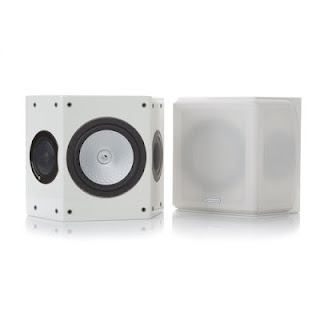My original side surround speakers were an excellent PSB 10S Bipoles. But due to a structural issue, I originally had them mounted high up on a shelf, about 2.2m above the floor and about 4 feet above my listening position. This resulted in an uneven sound experience and the Audyssey compensated by turning up my left surround much louder than my right. Furthermore, i could not get the enveloping effect I was used to with my old setup, as the speakers were near the ceiling, and a little recessed on the Ikea shelf. Now you may think that it was no big deal, but it resulted in a rather unsatisfactory ambience and it was hard to feel the surround experience I had created before.
So I decided on a few options:
a - bring them down and drill a hole into them and mounted them underneath the old shelf in an underslung fashion.
b- I also researched into the Monitor Audio options, since I was already using them for the front speakers. This seemed to be the better option for a few reasons.
One the drivers of the new RX series were more similar to my older GS series, allowing for a more seamless integration. The RX FX speakers also had a switch which allowed them to be either bipole or dipole.
There was a pair of mounting lugs behind, which allowed the speakers to be mounted almost flush with the side walls without a shelf or a bracket. And this suited my narrow long room better. There is a whole debate on the dipole / bipole issue, and here is a link to a good article on the matter: (
http://forum.blu-ray.com/showthread.php?t=170720).
Of note is that you use the Dipole mode in a way such that you sit in the null zone between the two tweeters, to give a very diffuse sound and I found this to be more ideal since my sitting position was almost exactly between the two side surrounds.
Some specs and info on the MA RXFX:
 It's widely understood that the sound of surround TVs cannot compete with the excitement of a properly designed and equalised home theatre system. But great sound comes at the expense of living space…until now. The wall-hugging RX-FX surround speaker reconciles the problem by providing a convincing, enveloping timbre-consistent surround sound that places you on the edge of your seat and at the heart of the action. Discreet enough to be flush-mounted on side or rear walls, the RX-FX design will blend with the system and your décor so completely you'll wonder why you ever thought of compromise. It's also immensely flexible sonically, offering direct or diffuse sound effects at the flick of a switch.
It's widely understood that the sound of surround TVs cannot compete with the excitement of a properly designed and equalised home theatre system. But great sound comes at the expense of living space…until now. The wall-hugging RX-FX surround speaker reconciles the problem by providing a convincing, enveloping timbre-consistent surround sound that places you on the edge of your seat and at the heart of the action. Discreet enough to be flush-mounted on side or rear walls, the RX-FX design will blend with the system and your décor so completely you'll wonder why you ever thought of compromise. It's also immensely flexible sonically, offering direct or diffuse sound effects at the flick of a switch.
- Flush to wall placement, with recessed termination.
- Drivers match with other Rx loudspeakers for consistent timbre and consistency.
- Dual di-pole/ bi-pole modes easily selected by switch operation.
- New C-CAM® tweeter design with damped rear chamber, providing improved clarity and wider operating range to make better use of HD audio formats
- Single 6" C-CAM® bass/mid-range driver incorporating RST® technology, for better damping and improved mid-range clarity.
- Selected premium quality wood veneers or high gloss piano finishes.
- Acoustically matched with all other Rx speakers for excellent imaging and consistency of timbre in surround applications.
Specification
| Item | Value |
|---|
| System Format: | 2 Way |
|---|
| Frequency Response: | 60Hz - 35kHz |
|---|
| Sensitivity (1W@1M): | 89dB |
|---|
| Nominal Impedance: | 6 Ohms |
|---|
| Maximum SPL (dBA): | 111.8 |
|---|
| Power Handling (RMS): | 80W |
|---|
| Recommended Amplifier Requirements (RMS): | 10-80W |
|---|
| Bass Alignment: | Sealed Cabinet |
|---|
| Tweeter Crossover Frequency: | 2.1kHz |
|---|
| Drive Unit Complement: | 1 x 6" RST® Bass/Mid driver.
2 x 1" (25mm) C-CAM® gold dome tweeters |
|---|
Product External Dimensions:
(H x W x D) | 250 x 300 x 120 mm
(9 13/16 x 11 13/16 x 4 3/4 inch) |
|---|
| Individual Weight: | 4.69 Kg (10.38 lb) |
|---|
I found that the experience with these speakers in the dipole mode, sited about 75 cm above my listening position was pretty good and I then swopped the PSB bipoles to the rear back position. This was also an improvement as the rear backs were in a less than ideal or Dolby dictated position and still allowed for a good spread of the sound in the rear soundstage.




Comments
Post a Comment